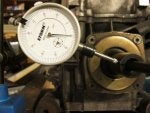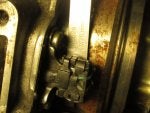I have 2 x two stroke engines that need a rebuild, a 797 (800R) and a 995 (1000 SDI) that will be done among my local group.
First off is a closer look at the 797 (800R). So far it has lasted many years without a hiccup. A closer inspection upon removing the clutch towards the end of the the 2014/2015 season revealed a big problem with Isoflex leaking out of the PTO side crank bearing seal. It was no surprise that this was part of Ski-Doo's preseason maintenance list.
We filled the PTO outer bearing with Isoflex NB5051 and chanced it for the few rides it had left. The sled was then grounded/replaced for the 2015/2016 season with a 2010 600RS so we haven't had to worry about it until now.
The engine is being considered for a swap on the RS so it's time to scratch the surface and dig deeper to see what we have to work with.
![]()
First off is a closer look at the 797 (800R). So far it has lasted many years without a hiccup. A closer inspection upon removing the clutch towards the end of the the 2014/2015 season revealed a big problem with Isoflex leaking out of the PTO side crank bearing seal. It was no surprise that this was part of Ski-Doo's preseason maintenance list.
We filled the PTO outer bearing with Isoflex NB5051 and chanced it for the few rides it had left. The sled was then grounded/replaced for the 2015/2016 season with a 2010 600RS so we haven't had to worry about it until now.
The engine is being considered for a swap on the RS so it's time to scratch the surface and dig deeper to see what we have to work with.























